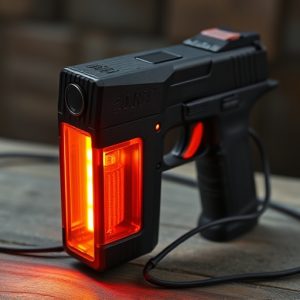Decoding the Runt Stun Gun’s Voltage: A Guide to Safe and Effective Use
The Runt stun gun is a compact self-defense device capable of delivering high-voltage shocks (400kV…….
The Runt stun gun is a compact self-defense device capable of delivering high-voltage shocks (400kV to 500kV) for personal safety. Its design incorporates safety measures such as a safety switch and high resistance grip to prevent accidental discharges. The voltage is calibrated to be effective in incapacitating an attacker while ensuring the user's safety. The stun gun works by emitting a high-voltage, low-ampere charge that induces muscle spasms and neuromuscular incapacitation through rapid electron movement between electrodes. It's crucial for users to understand how the device operates and to handle it responsibly, as proper training enhances its effectiveness and ensures user safety. Regular practice and maintenance are necessary to use the Runt stun gun proficiently, adhering to safety protocols and legal regulations governing its use. Users should be aware of the potential for the shock to reflect off certain surfaces and injure others, so they must use it judiciously in self-defense situations. Compliance with manufacturer guidelines and local laws is essential for the safe and lawful utilization of the Runt stun gun.
When it comes to personal safety devices, the “runt stun gun” stands out as a compact yet effective self-defense tool. This article delves into the electrical dynamics of these devices, particularly focusing on their voltage. Understanding the voltage behind a runt stun gun is crucial for assessing its safety and effectiveness in real-world scenarios. We explore the science that powers these small but mighty devices and offer tips to maximize their potential while ensuring user safety. Join us as we unravel the intricacies of the runt stun gun’s voltage, a critical aspect of its design and operation.
Understanding the Runt Stun Gun's Voltage: A Closer Look at Safety and Effectiveness
The Runt stun gun is a self-defense device that, despite its compact size, delivers a high-voltage electric shock to incapacitate an attacker. Its voltage is a critical factor in determining both its safety for the user and its effectiveness in deterring or neutralizing a threat. A stun gun’s voltage is measured in kilovolts (kV), and while higher voltages can be more effective, it’s crucial to handle such devices with care to avoid accidental discharge. The Runt model, typically delivering between 400kV to 500kV, offers a balance between potency and manageability. This voltage range is sufficient to deliver a powerful shock while remaining within a level that minimizes the risk of misuse or injury to the user.
When evaluating the safety and effectiveness of a Runt stun gun, it’s important to consider the design and construction of the device. Manufacturers often incorporate multiple layers of protection, including safety features like a locked-on safety switch and a high resistance path through the grip for added security. These measures ensure that the stun gun operates only when intentionally activated by the user, reducing the likelihood of an unintended shock. Additionally, the voltage output is calibrated to be strong enough to deter aggressors yet controlled to avoid causing harm beyond incapacitating them. Understanding the nuances of how the Runt stun gun’s voltage works is essential for users to use the device effectively and safely, ensuring they are prepared in situations where personal safety may be compromised.
The Science Behind the Runt Stun Gun's Electrical Output
The effectiveness of a stun gun, including the compact and potent ‘runt stun gun,’ is rooted in its ability to generate an electric current that incapacitates adversaries. This device harnesses a high-voltage, low-ampere electrical charge, which is delivered through two electrodes. The science behind this output involves the rapid flow of electrons across the gap between these probes. When activated, the stun gun disrupts the normal functioning of the body’s muscular and neural systems, leading to muscle spasms and neuromuscular incapacitation. This effect is due to the electrical current causing depolarization of muscle cell membranes and the activation of motor nerves, resulting in uncontrolled contractions.
The voltage output of a runt stun gun is specifically designed to be both effective and safe for the user. It operates at a voltage level that, when properly applied, can cause significant discomfort or immobilization without causing lasting harm. The key to the stun gun’s efficacy lies in its ability to deliver a shock that is strong enough to trigger the body’s pain response while avoiding lethal consequences. Manufacturers of runt stun guns often emphasize the importance of understanding the electrical output, as it directly correlates with the device’s performance and user safety. Users must be trained on how to handle the device correctly to ensure its effectiveness when needed for self-defense.
Maximizing the Potential of Your Runt Stun Gun: Usage Tips and Safety Precautions
When deploying a runt stun gun for self-defense, it’s crucial to understand its capabilities and limitations. Unlike larger models, the runt stun gun is designed to be compact and concealable, making it an ideal choice for individuals who prioritize portability without compromising on safety. To maximize its potential, ensure you familiarize yourself with its operation under non-emergency conditions. Regular practice with your device will help you become adept at accessing its features quickly and effectively. The runt stun gun typically offers a voltage that, while not the highest among available stun guns, is still sufficient for deterring attackers by delivering a high-voltage electric shock that incapacitates them. For optimal performance, regularly maintain your stun gun by checking its batteries, ensuring they are fully charged before carrying it. Additionally, avoid exposing the device to extreme temperatures, as this can affect its functionality.
Safety should always be at the forefront when using a runt stun gun. Never brandish it as a threat or use it in a manner that could harm an individual unintentionally. Understand the legal implications of deploying a stun gun in your jurisdiction, and only use it when faced with an immediate threat to your safety. In such situations, aim for the attacker’s larger muscle groups, like the torso, arms, or legs, to deliver the electric shock effectively. Remember to consider the environment around you; avoid using the stun gun near water or in confined spaces where the shock could reflect back towards you or an innocent bystander. Always adhere to the manufacturer’s guidelines and local laws regarding the use of stun guns for personal defense.


